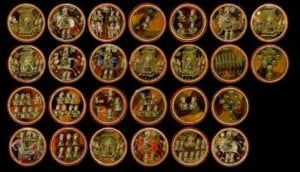class="post-6872 post type-post status-publish format-standard has-post-thumbnail hentry category-ashvapati category-dhanpati category-gajapati category-ganjifa-cards category-kridapatram category-mahabharatha category-narpati category-ramayana category-senapati">
The picture above that’s been displayed looks like a painting, but in reality it is one of the leaves from ‘playing cards’, used by ancient Indians to play the game of cards, also called as ‘kridapatram’. According to the Aphilomath Journal, this game of cards originated in ancient India, where the cards were made of cloths and the motifs depicted the Ramayana and Mahabharatha.
Cards having Ramayana and Mahabharata motifs
The playing cards were called as ‘ganjifa cards’, in medieval India, and is believed to be played by the royals. It’s been recorded that the Ganjifa was played in areas of Rajputana, Kashyapa Meru (Kashmir), Utkala (Orissa), the Deccan and even in Nepal. Each area had their own version of making cards and motifs depended on the culture and history of the place.
Cards depicting the Dash avatar from West Bengal
Later the Mughals took the game of cards further and According to Abul Fazal’s (Author of the Ain-e-Akbari ), he describes the cards used by the mughals, where the first set of cards depicted Ashvapati which is the ‘lord of horses’. The Ashvapati which was ranked the highest card in the pack, represented the picture of the king on a horseback. The second represented a General (Senapati) on a horseback. After this card came ten other cards with pictures of horses from one to ten. Another set of cards had the Gajapati (lord of elephants) which represented the king whose power lay in the number of elephants. The other eleven cards in this pack represented the Senapati and ten others with a soldier astride an elephant. Another pack had the Narpati, a king whose power lies in his infantry. The other cards were known as the Dhanpati, the lord of treasures, Dalpati the lord of the squadron, Navapati, the lord of the navy, Surapati, the lord of divinities, Asrapati, the lord of genii, Vanapati, the king of the forest, Ahipati, the lord of snakes and so on. (Excerpt from the Aphilomath Journal)

A mughal set of playing cards.
The cards were all hand made, by pasting layers of clothes traditionally handcrafted and hand painted. The the cards were made according to the likes of the king. It’s been a habit of making the cards circular, with oval and rectangular cards being seen now and then. This art of making cards has been existent for over hundred years and died slowly by the advent of the Europeans who took over in the 17th – 18th century, where they started producing cards made of paper.
This blog will be followed by attitudes about play during the other periods of Medieval India, which will be a perfect closure to the history of Indian play.
Picture sources are from Google images and Pinterest.
By Dr Srividya K.